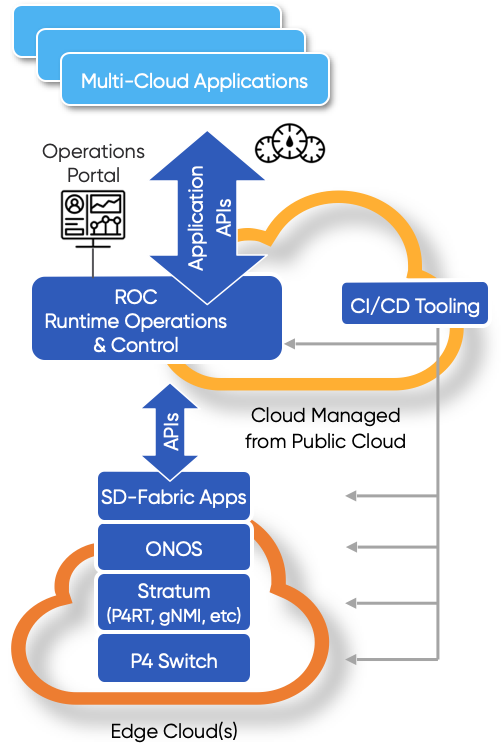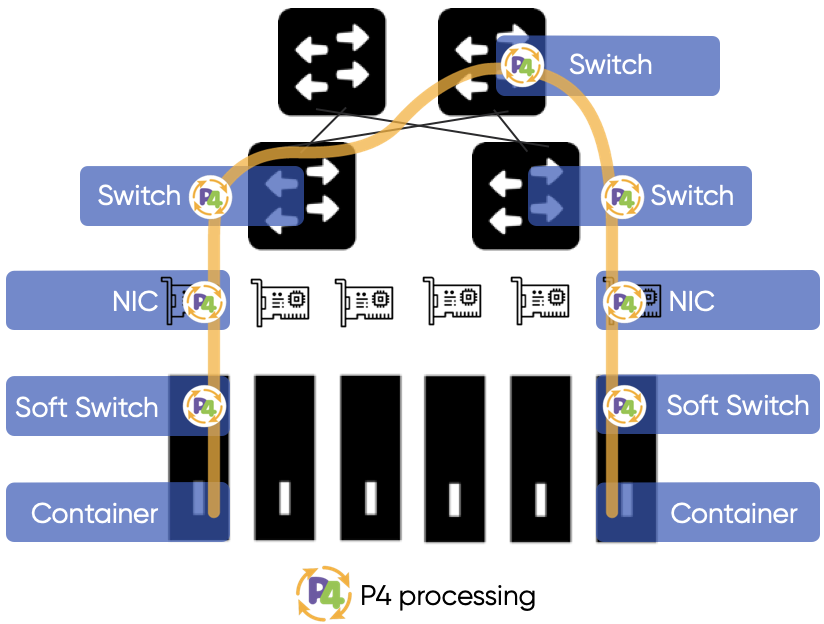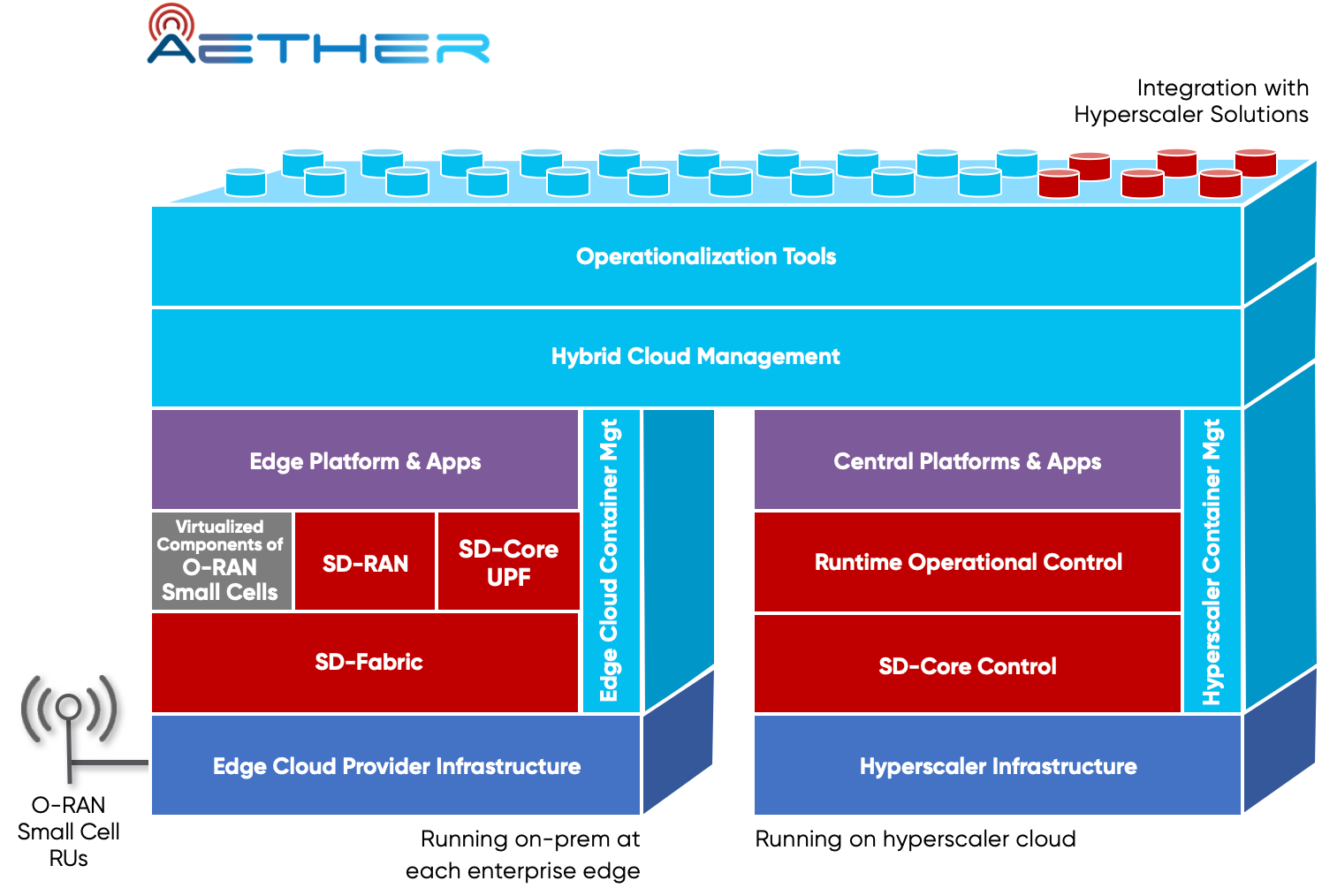June 24, 2021 MENLO PARK, Calif. - The Open Networking Foundation (ONF) today announced the open source SD-Fabric project, a complete P4-programmable hybrid cloud network fabric giving programmers the power to push customized packet processing deep into networking elements. SD-Fabric is a developer-friendly, cloud-managed, full stack, programmable network fabric that enables new classes of emerging edge applications for Industry 4.0 powered by 5G.
SD-Fabric supports the creation of customized edge clouds, exposing fully programmable networking resources via SaaS APIs that enable programmers to create advanced applications while reducing the CPU compute power needed for edge-centric applications. Application functionality can be accelerated with P4 functionality running in networking switches, and eventually in P4 programmable server NICs and soft switches, thereby improving performance while reducing costs and footprint.
SD-Fabric is available now in open source, and is deployed in as part of the Aether network supporting project Pronto where the programmability of SD-Fabric is enabling fine-grained measurement, network verification and closed loop control via simple APIs to create more resilient, reliable, secure 5G networks.
Introducing SD-Fabric
SD-Fabric is a full stack implementation designed to run a thin layer of software on white box switches, executing localized control at the edge cloud, with multiple edges controlled from the public cloud. The entire stack from the switch all the way through to the public cloud is deployed and managed in a cloud-native fashion, running on Kubernetes, with a complete CI/CI pipeline, and fully integrated logging, monitoring, alarming, etc.

At each edge, SD-Fabric builds a spine-leaf fabric (from 1 to 32+ switches), running the Stratum thin switch OS on white box P4 capable switches. This is controlled by the ONOS SDN controller and by a number of fabric applications running in the edge cloud.
SD-Fabric can be deployed as-a-service, and exposes northbound APIs to enable developers to request advanced capabilities of the network such as load balancing, in-band telemetry, custom protocol processing, and much more. Cloud-native applications can be multi-cloud aware, splitting functionality between the edge and public clouds in order to place all workloads where they are best suited.
SD-Fabric provides a full complement of classic connectivity functionality (such as L2, L3, Multicast and ACLs). Hosts and applications require no modification to run on SD-Fabric, but the network is designed and controlled by SDN applications running on the edge cloud by ONOS rather than in embedded software running on all the individual switches in the network. This greatly simplifies the running of the network, and provides opportunities for the applications and the network to all be controlled by the same CI/CD DevOps stack by the same set of developers.
But SD-Fabric then goes a step further. Application functionality can be defined in the P4 language and applications can then manage this forwarding logic directly in the networking elements themselves. This approach frees up CPU cores for other tasks and can unleash terabits of capacity for packet transformation, redirection, modification, tracking/counting, and for directly reacting and responding to traffic from within the network. Simple tasks like load balancing can be performed, but complex application functions like database cache front ends or DNS server implementations have been developed using this model. SD-Fabric makes this full suite of power available to the application developer.

SD-Fabric enables the programming of the forwarding behavior
at each hop along of the entire path between compute nodes:
Container - SoftSwitch - NIC - Switch - Switch - Switch - NIC - SoftSwitch - Container
Network Verification and Closed Loop Control
The programmability of SD-Fabric has already been used to create verification and closed loop control capabilities that now are natively available as part of the SD-Fabric stack. Fine-grained measurement through the use of in-band network telemetry (INT) tracks all traffic and queue behavior through the fabric, and this is coupled with network verification and closed-loop control applications that help ensure continuous uninterrupted operation. DoS attacks can be automatically quelched, and unexpected network behavior automatically identified and mitigated. This work is coming out of the Pronto project, where SD-Fabric and Aether form the foundational platform for the Pronto research advancing secure 5G infrastructure. Pronto is ongoing, and will continue to upstream enhancements back into the SD-Fabric project.
"Intel has been collaboratively working with ONF and the SD-Fabric project on the development of network programmability using 3rd Gen Intel Xeon Scalable processors, Intel Tofino P4-programmable Ethernet switch ASICs, Intel FPGAs and Intel Ethernet 800 Series Network Adapters,” said Ed Doe, Intel Vice President and General Manager Barefoot Division. “This is an ideal mix of Intel's networking technologies that serves a variety of high throughput use cases where deterministic performance is required. The overall system solution harnesses in-band network telemetry (INT) along with Intel Deep Insight Network Analytics Software to enable resilient, more secure and self-healing infrastructure"
Relationship to Aether
Aether is ONF’s Enterprise 5G-Edge-Cloud-as-a-Service platform enabling turnkey deployments of private 5G networks for enterprises. SD-Fabric is an integral part of Aether (alongside the SD-RAN™ and SD-Core™ projects), and Aether’s Runtime Operational Controller (ROC) includes adapters for controlling SD-Fabric in coordination with the end-to-end Aether platform. For example, ROC can deploy network slices that will reserve end-to-end resources from the RAN through SD-Fabric and the mobile core, leveraging P4 in the network fabric to partition the slices and guarantee performance.

“Dell Technologies is building solutions for the emerging private 5G market for enterprises Projects like ONF’s SD-Fabric, SD-RAN and SD-Core are well suited to provide open source options for building solutions for this market.”
– Ihab Tarazi, CTO and SVP, Networking and Solutions, Dell Technologies
“China Mobile is implementing IPv6 segment routing with header compression using SD-Fabric. It gives us the ability to fully program the forwarding path, allowing us to implement this new emerging IETF Draft (G-SRv6) without waiting for a switch vendor to release a new ASIC supporting the protocol and new header formats. Our ability to create a custom solution such as this is a testament to the power of SD-Fabric and P4, and demonstrates the desire of operators to be able to rapidly innovate with customized solutions.”
– Weiqiang Cheng, Technical Manager, China Mobile Research Institute
“NTT has deployed SD-Fabric and SD-Core in our lab as part of Aether where we are evaluating advanced solutions for enterprise local 5G. We are excited by the possibilities offered by this novel fully programmable solution, and believe that P4 programmability has an important role to play in future network deployments.”
– Dai Kashiwa, Evangelist, Director of NTT Communications
Learn More
SD-Fabric standalone is available now under the Apache 2.0 open source license. SD-Fabric, with full P4 programmability for Intel Tofino and full Aether integration, is currently available to ONF members under the ONF member-only software license, and will be released as open source as part of the ONF release process later this year.
To learn more, please visit:
The public is invited to attend a live virtual session introducing SD-Fabric. Project leaders and technical experts will provide an overview and share insights into the platform, field questions from the community:
- SD-Fabric Techinar: July 8, 2021 at 9:00 PDT - Register Here
About the Open Networking Foundation:
The Open Networking Foundation (ONF) is an operator-led consortium spearheading disruptive network transformation. Now the recognized leader for open source solutions for operators, the ONF first launched in 2011 as the standard bearer for Software Defined Networking (SDN). Led by its operator partners AT&T, China Unicom, Deutsche Telekom, Google, NTT Group and Türk Telekom, the ONF is driving vast transformation across the operator space. For further information visit http://www.opennetworking.org
Intel, the Intel logo, and other Intel marks are trademarks of Intel Corporation or its subsidiaries.
